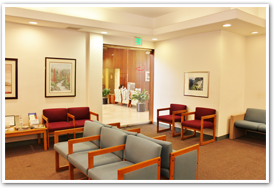Coronary angiography is normally performed through a needle puncture and sheath insertion in the femoral artery (one of the largest caliber arteries of the body). As such, once the procedure is over, the greatest risk is for significant bleeding from the puncture site. Thankfully, this is relatively rare.
When the sheath is removed, we sometimes put a "closure device" which is usually a little collagen plug to decrease the amount of time you need to lie flat once the procedure is over…. Even if you got one of these, you are still at risk for bleeding however!
We are conveniently located in West Hills, CA

Have you received a closure device? YES NO
What can you do?
- Most importantly is no heavy lifting or straining for two weeks after the procedure. Heavy lifting is generally considered over 20 pounds. Straining or lifting puts a lot of pressure on that area which is busy healing.
- Most people can go back to light duty work within a day or two after the angiogram (if you have a very active job, I might advise you to wait longer).
- You should wait at least 5 days before resuming your exercise regimen, and the required two weeks if it involves heavy lifting.
What should you watch out for?
- A little soreness after the procedure is not uncommon. However, significant pain can be a sign that something is wrong. Call us, or be seen by a physician
- Any bleeding is abnormal. Even a small ooze. Call us immediately. If you have a lot of bleeding, or the blood flow is pulsating or bright red, don't waste time calling us, call 911
- Many patients have some bruising in the area. However, if the bruising is accompanied by a lump (often the size of a golf ball or larger), there may be bleeding under the skin. This can be serious and you should be evaluated by a physician.
- Signs of infection may include pain, warmth, redness (especially if it is spreading), or fever. Be on the lookout for these, especially if you have received a "closure device"
- Symptoms may not be confined to the area of the procedure. If you have new pain radiating down the leg or foot, or it suddenly becomes pale or cold, this may be related. Likewise, any new and unusual back pain, problems urinating, or bruising on the flanks or abdomen may be related. A decrease in urine output or unexplained swelling may represent a problem with the kidneys. In the unlikely event of any of these occurrences, you should seek medical attention immediately.
Any time we access such a major artery, there is a potential risk of bleeding or other problems. However, the procedure was performed because the potential benefits outweighed the potential risks.







